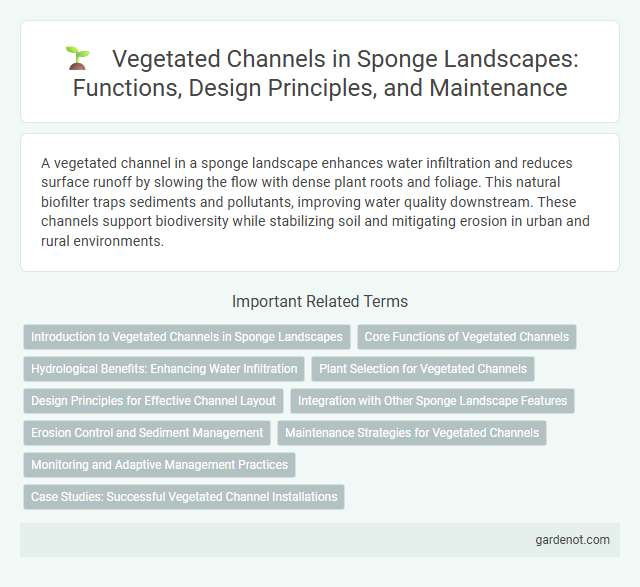A vegetated channel in a sponge landscape enhances water infiltration and reduces surface runoff by slowing the flow with dense plant roots and foliage. This natural biofilter traps sediments and pollutants, improving water quality downstream. These channels support biodiversity while stabilizing soil and mitigating erosion in urban and rural environments.
Introduction to Vegetated Channels in Sponge Landscapes
Vegetated channels in sponge landscapes serve as natural conduits for stormwater, enhancing infiltration and reducing surface runoff while supporting diverse plant species adapted to periodic flooding. These channels improve groundwater recharge by slowing water flow and facilitating sediment deposition, which also promotes soil stabilization. Effective design and maintenance of vegetated channels optimize their role in managing urban water resources and mitigating flood risks.
Core Functions of Vegetated Channels
Vegetated channels play a crucial role in sponge landscapes by enhancing stormwater infiltration and reducing surface runoff, thereby mitigating urban flooding. These channels also improve water quality by filtering pollutants through plant roots and soil media, promoting groundwater recharge. Vegetated channels support biodiversity and stabilize soil, preventing erosion while sustaining ecosystem health.
Hydrological Benefits: Enhancing Water Infiltration
Vegetated channels significantly improve hydrological performance by enhancing water infiltration through dense root systems and permeable soil layers. These channels reduce surface runoff, promoting groundwater recharge and minimizing flood risks in urban and rural landscapes. Their integration into sponge landscapes supports sustainable water management by increasing soil moisture retention and improving overall ecosystem resilience.
Plant Selection for Vegetated Channels
Selecting native, deep-rooted perennial plants is critical for vegetated channels in sponge landscapes to optimize water infiltration and stabilize soil. Species such as switchgrass (Panicum virgatum), blue flag iris (Iris versicolor), and sedges (Carex spp.) enhance pollutant filtration and provide erosion control under varying flow conditions. Integrating diverse plant communities with high tolerance to periodic flooding improves resilience and maximizes nutrient uptake in these sustainable stormwater management systems.
Design Principles for Effective Channel Layout
Vegetated channels in sponge landscape design optimize stormwater management by enhancing infiltration and pollutant removal through strategic alignment with the natural topography. Incorporating gentle gradients, stable bed materials, and native plant species ensures hydraulic efficiency while promoting biodiversity and soil retention. Effective channel layout balances flow velocity control with sediment deposition to prevent erosion and maintain long-term channel stability.
Integration with Other Sponge Landscape Features
Vegetated channels serve as critical components within sponge landscapes by enhancing water infiltration and sediment retention through dense plant root systems. Integration with bio-retention ponds, permeable pavements, and rain gardens amplifies their effectiveness in reducing surface runoff and improving groundwater recharge. This synergy supports urban flood mitigation and promotes biodiversity by creating interconnected habitats within the landscape.
Erosion Control and Sediment Management
Vegetated channels utilize dense plant roots and soil-binding vegetation to effectively reduce erosion by stabilizing channel banks and slowing water flow, which minimizes sediment displacement. These channels enhance sediment management by trapping and filtering sediments within the vegetation, preventing downstream sedimentation and maintaining water quality. Integration of native plants tailored to local hydrology maximizes erosion control and promotes sustainable sediment retention in sponge landscape designs.
Maintenance Strategies for Vegetated Channels
Vegetated channels require regular inspection and removal of sediment buildup to maintain hydraulic efficiency and prevent blockages. Strategic pruning and replanting of native vegetation enhance channel stability and promote biodiversity while reducing erosion risks. Implementing adaptive management practices based on seasonal growth patterns ensures sustained channel functionality and environmental benefits.
Monitoring and Adaptive Management Practices
Vegetated channels in sponge landscapes play a critical role in enhancing water infiltration and reducing surface runoff by supporting diverse plant species that stabilize soil and filter pollutants. Monitoring through remote sensing technologies and in-situ water quality assessments enables the detection of vegetation health, sediment accumulation, and hydrological changes critical for adaptive management. Adaptive management practices involve adjusting planting regimes, flow control structures, and invasive species removal based on real-time data to optimize ecological function and resilience.
Case Studies: Successful Vegetated Channel Installations
Case studies of successful vegetated channel installations reveal significant improvements in stormwater management and erosion control. Projects such as the Cheonggyecheon Stream restoration in Seoul and the Kissimmee River rehabilitation in Florida demonstrate increased biodiversity, enhanced water quality, and improved flood mitigation. These examples highlight the effectiveness of native plant species and engineered soil media in stabilizing channel banks and promoting sustainable urban drainage systems.
Vegetated channel Infographic

 gardenot.com
gardenot.com